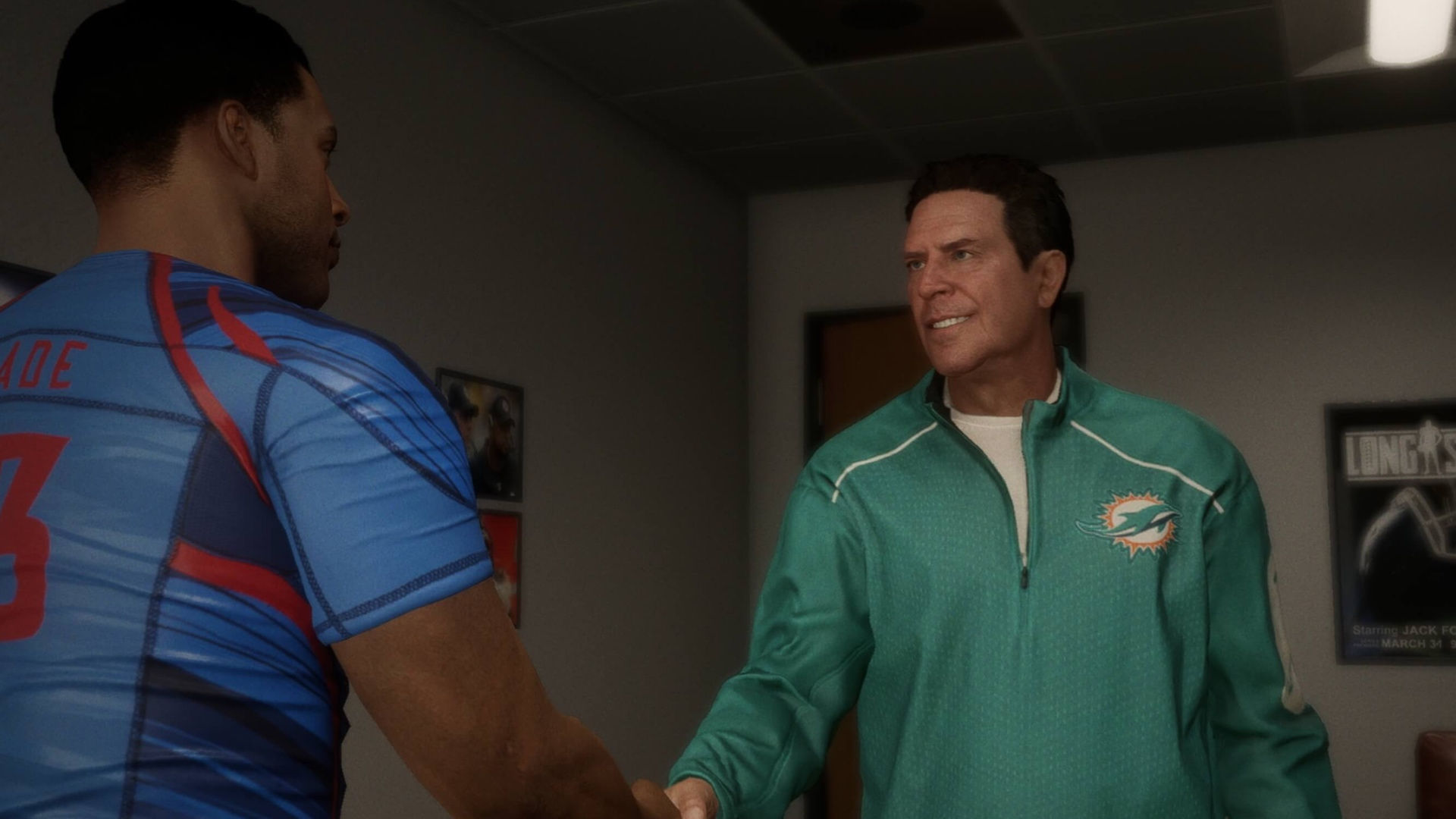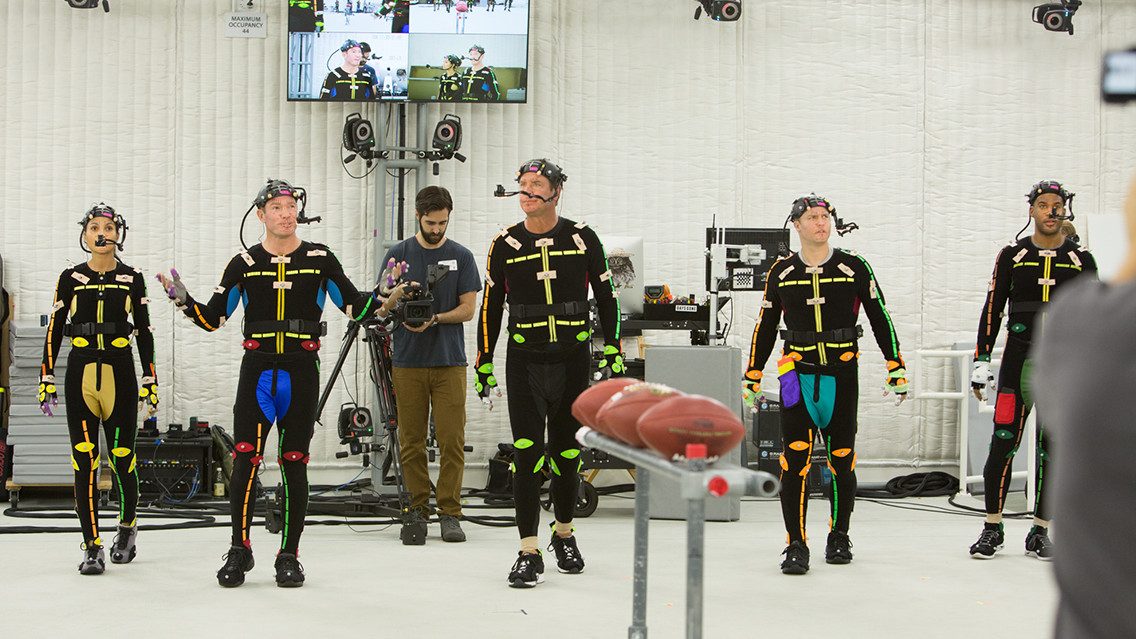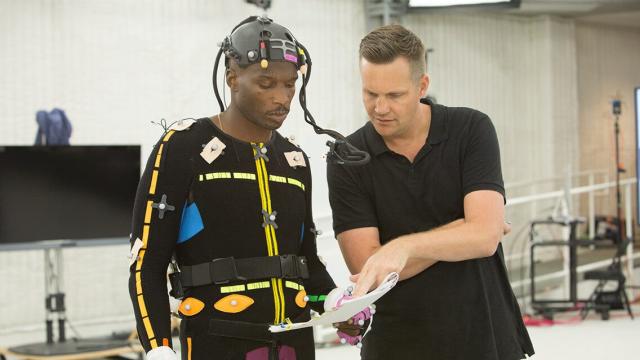Director Mike Young gives notes to former NFL player Chad Ochocinco. (Photo via EA)
Longshot, the interactive drama behind this year’s Madden, tells the story of a man who tries to beat the odds to accomplish an impossible dream. The tale behind the making of Longshot is similar.
Mike Young started working as an art director on Madden in 2007, and even then, he was dreaming of adding a story mode to the behemoth football game series. “That had been a mission of mine,” he told me during a recent interview.
“I pitched a million different things … there weren’t a lot of things out there like it, so it’s very hard to sell.”
He wanted to tell a story about an NFL player who had no accolades, one who wasn’t a guaranteed superstar. In Young’s mind, the perfect Madden storyline would center on a player who might not make it to the NFL.
Young, whose résumé is full of sports games like NBA Street and SSX, is an artist by trade. He’s sold sports photographs to news outlets and had a hand in integrating Madden cover athletes into the menus and loading screens of each game.
But he’s always had a soft spot for stories, and as Young tells it, his favourite games don’t involve scoring touchdowns or putting balls in hoops. In the summer of 2013, when Naughty Dog released The Last of Us, a game about survivors of a zombie apocalypse, Young was inspired. “The survival relationships were so believable, so relatable,” he said.
“I just kept thinking: Why can’t we aim for this quality of storytelling in a sports game?”
The developers of Madden had other things on their minds. With a yearly release cycle and very little time to iterate between each game, they were busy worrying about improving graphics and tweaking gameplay, adding features to improve offensive line play and make defences more interesting.
After Madden 13, the team at EA Tiburon had to pinpoint the problems and fix them for Madden 14. After Madden 14, the team had to think about what to make better in Madden 15. And so on. (Sports games follow a consistent pattern.)
If Mike Young was going to add a story mode to Madden, he’d have to do it on his own, or at least with a small team. So he went to his executive producer with a pitch, one about an underdog who was trying to make it into the National Football League.
Young got a budget of $US30,000 ($37,672) to start putting together a short video based on his story. “I loved those parts in Hard Knocks, and Undrafted — shows like that are a lot more emotionally engaging to me than just the superstar lifestyle stuff,” Young said.
“I really wanted to focus on something that we as sports gamers can relate to. We have dreams of playing probably pro sports at some point, but there are reasons we didn’t make it, reasons we give up on dreams.”

Former quarterback Dan Marino has a significant role in Madden’s Longshot mode.
For the next two years, while also working on each new iteration of Madden, Young started researching and prototyping ideas for what would eventually become Longshot.
Alongside a slowly expanding team of designers and producers, he started playing with mechanics and ideas. He went to NFL training camps and interviewed players about their experiences, prodding them with questions about what it’s like to make it big.
Inspired by Telltale’s The Walking Dead adventure series, Young decided that his story mode would be like an interactive movie, with gameplay consisting of mini-games, dialogue choices, and high school football matches. “I wrote a few scenes and put them in front of people,” he said. “They were like, ‘Wow this is way different than I thought. It’s really emotional.’”
Conservative executives were sceptical. This was long before the rise of NBA 2K‘s cinematic narratives and EA’s own FIFA: The Journey, and executives at the multi-billion-dollar publisher didn’t want to mess with a winning formula.
Why take a risk on something new when millions of people were already buying Madden every year? Why not focus on what already worked? (EA’s 2011 boxing game, Fight Night Champion, had an acclaimed story mode, but that was a boxing game, a relatively niche release compared to EA’s team sports juggernauts, all with their polished pathways to annual success.)
Madden 15, released in August 2014, provided a breakthrough for Young. While making that game, he and his team put together an interactive intro that would let you play as cover star Cam Newton in a high-stakes game between the Panthers and the Seahawks.
It was shot like a dramatic film, complete with coaches barking and Newton shouting plays in the huddle. You’d get control of the Panthers with less than two minutes left in the fourth quarter, needing a touchdown to win.
This interactive intro was short, essentially a glorified tutorial, but it made an impact. Wrote one reviewer: “With luck, the ‘First Interactive Experience’ will prove to be a preview of the future and we’ll get more of those great in-game cinematics soon.”
“That was a huge motivator for getting greenlit,” said Young. “I think before that, there were doubts from people as to whether sports gamers wanted any kind of story. [Then] we heard a lot of, ‘Wow this is awesome. Why can’t the rest of Madden be like this?’”
After more prototyping, pushing, and pitching, Young convinced EA to greenlight the story of Devin Wade, an impressive high school quarterback whose meteoric rise would come to a halt after the death of his father.
Wade, along with his best friend Colt Cruise (played by actor Scott Porter, who Young recruited early), would compete on a reality TV show called Longshot in hopes of attracting enough NFL attention to get drafted.
Neither of them would ever be first-rounders, but depending on the player’s choices, one or both could get a shot at playing professionally. It would be like a cross between Friday Night Lights and a Telltale game.
Even with EA’s approval, Young still had convincing to do. Throughout 2015, 2016, and even the final months of development in 2017, Young found himself continuing to pitch Longshot, both internally and externally. Sceptical executives would offer notes — “can we get some NFL games in here?” — while playtesters would complain that there was too much cinema, not enough gameplay.
Although Longshot‘s core story beats never changed, the development team did scrap features, adjust mechanics, and rewrite scenes to please higher-ups.
In one early scene, for example, the fictional NFL coach Jack Ford is teaching Devin Wade the basics of play-calling. During this scene, the player must correctly identify positions and formations on the football field.
The original version of this scene was stupidly simple, and after getting feedback that it should feel more true to football, Young and his team spiced it up. Rather than shirk at the difficulty, playtesters appreciated that it felt real.
Some of the scepticism Young encountered helped. “There [are] great allies that give you the energy to keep going, and then there’s also the people who don’t believe in it, and that kind of gives you energy too,” he said.
“When you do something that hasn’t been done in a sports game, at least with this kind of format, people will worry. And it made almost every day a challenge, too. You’re always pitching, even after you’re greenlit.”
In addition to pitching, Young spent his days writing and rewriting the script, fine-tuning gameplay mechanics, and working with actors. He’d go on the road for months at a time, directing everyone from small children to Academy Award winners (namely, Mahershala Ali).
As he worked with actors, he’d have to answer questions from set designers, cinematographers, the composer, and designers on the home team.
“Every day was high pressure,” he said. “Up at 6am preparing for that day, usually falling asleep preparing for the day. Dreaming about the day — not fun dreams, just like, exactly what you would do the next day, over and over again.”
Young’s team might lose an hour of filming to technical difficulties, rewrite scripts on the fly, or realise that some characters weren’t working, eventually cutting the cast down from 60 to 45. It was a long, gruelling process for Young, who called it “an all-encompassing 24-7 job.”

Actors work on the set of Madden’s Longshot. Photo via EA
By August 2017, Young and his team were exhausted, but they had a feeling they’d made something solid. Testers and reviewers were impressed by the production values of Madden 18‘s Longshot mode.
The writing and acting were shockingly good — miles better than anything we’d seen from NBA 2K, despite the latter’s ballyhooed contributions from director Spike Lee.
By the end of the game, it was hard not to feel some level of attachment to Devin and Colt, even if you couldn’t get both of them to the NFL. Their relationship felt grounded and real in a way we rarely see in any type of video game, let alone a sports game.
Young is already thinking about a sequel starring the pair of football players. He wouldn’t say if we’ll see Longshot 2 in the next iteration of Madden, but he does want to make it happen.
“I think they’re rich characters,” he said. “I think it’s very difficult to create characters that people like and engage with and feel empathy towards… And I think there’s more to their journey that could be told that would be really exciting.”
This time, it probably won’t take four years.

Comments
One response to “The Four-Year Journey Behind Madden’s Great Story Mode”
I really liked the story mode, but FOR THE LOVE OF GOD please make the cut-scenes skippable at least on second playthrough.